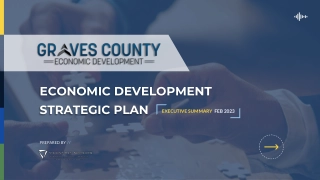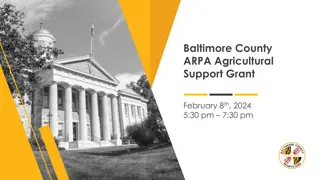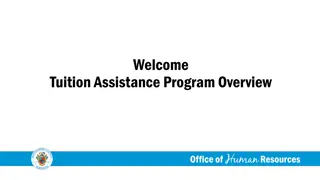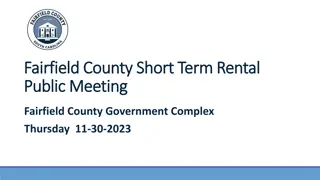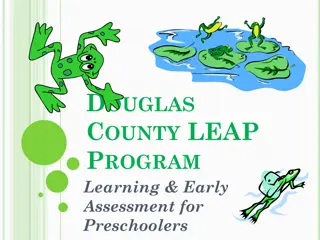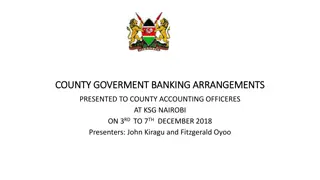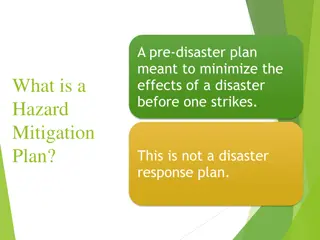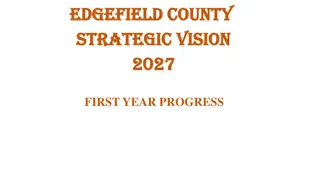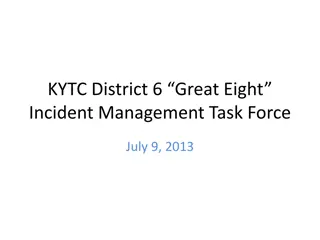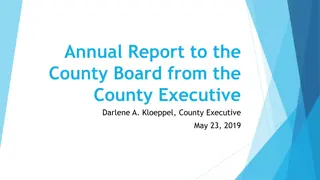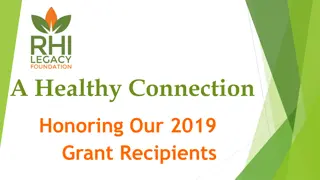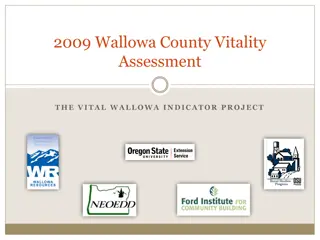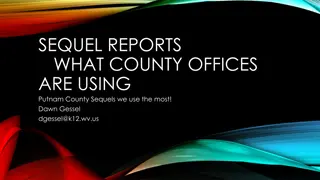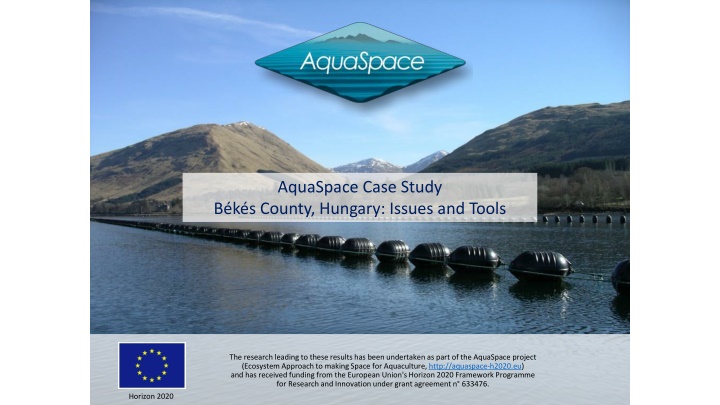
AquaSpace Case Study B.K.S County, Hungary: Spatial Issues in Aquaculture Development
Explore the spatial issues impacting aquaculture development in B.K.S County, Hungary, focusing on stakeholder opinions, ecosystem services, conflicts, and tools used for site selection and valuation of services.
Download Presentation

Please find below an Image/Link to download the presentation.
The content on the website is provided AS IS for your information and personal use only. It may not be sold, licensed, or shared on other websites without obtaining consent from the author. If you encounter any issues during the download, it is possible that the publisher has removed the file from their server.
You are allowed to download the files provided on this website for personal or commercial use, subject to the condition that they are used lawfully. All files are the property of their respective owners.
The content on the website is provided AS IS for your information and personal use only. It may not be sold, licensed, or shared on other websites without obtaining consent from the author.
E N D
Presentation Transcript
AquaSpace Case Study B k s County, Hungary: Issues and Tools The research leading to these results has been undertaken as part of the AquaSpace project (Ecosystem Approach to making Space for Aquaculture, http://aquaspace-h2020.eu) and has received funding from the European Union's Horizon 2020 Framework Programme for Research and Innovation under grant agreement n 633476. Horizon 2020
Where Where? ? Analysis of the impact of spatial issues on AQ development in freshwater environment (WP2&WP4) Stakeholder opinions on barriers to growth (questionnaire, workshop)
Case Case study study ISSUE ISSUE Spatial planning and management issues The main pond system is situated in the surroundings of the village Biharugra, which is the second largest fish pond system (1927 ha) in Hungary. The major species produced in Bekes is common carp, followed by tank-based production of African catfish. Development trends in freshwater pond culture are moving towards sustainable intensification Multi-annual national strategies involve a plan for: maintaining the current pond area for extensive aquaculture and strengthening its ecosystem services (habitat provision, microclimatic effects, landscape formation), modernization of existing production units (development and purchase of new technologies), diversification of the aquaculture sector in terms of produced species (with high market potential) and activities (multi-functionality, angling, ecotourism), knowledge transfer, exchange of best practices at the national level and also between MS, development of the post-harvest value chain and boosting the demand for freshwater products.
Case Case study study ISSUE ISSUE The most important issues Ecosystem services Conflicts between natural conservation and aquaculture producers - damage caused by predatory animals Proper site selection tools are missing National implementation of Water Framework Directive, Habitat Directive and Bird Directive how do influence aquaculture production in HU, CZ, PL (WP2) EAA: Lack of integrated watershed management (surface and subsurface water use, waste water treatment/disposal, urban runoff, excess water, draft etc.) Legal uncertaincy i.e. not clearly defined the priority in water use
Tools used in the case study Tools used in the case study GIS mapping-site selection method Databases-site selection method, valuation of ecosystem services Biophysical and sociocultural valuation of ecosystem services
Tools used in the case study Tools used in the case study GIS mapping-suitable sites selection
Tools used in the case study Tools used in the case study Databases-site selection method, valuation of ecosystem services Data requests Available data from General Directorate of Water Management Fish-farm water abstractions in the year 2013 (according to the statistical data of water users in general total water per year, sometimes monthly breakdown) for B k s county or bodies of water catchments concerning the B k s county. Other data sources Format excel Spatial and temporal variability of the water use in ponds 1 2 excel tables Spatial and temporal distribution of drained waters For the ponds drainage, the amount of used water is drained to the surface water bodies in the year 2013 (according to the statistical data of water users in general total water per year, sometimes monthly breakdown) for B k s county or bodies of water catchments concerning the B k s county. 2 excel Drained water quality indicators of the ponds (N, P, COD, turbidity or suspended matter) http://www.vizugy.hu/index.php?module=vizstrat&programelemid=149 Current data from Disaster Management Directorate in B k s county 3 Primarily GIS overlay of fish still waters for economic purposes 2015th data updated in April, B k s County shape Location of the ponds 4 shape Surface water resources Rate of August runoff and multi-annual average of norma stream flow and those water bodies which relate to the water distribution of the Szarvas district in B k s county 5 6 Spatial and temporal variability of surface waters Daily or monthy data of water flow measuring stations in B k s county Concerning Water Management Directorate 7 excess water hazardous area map Inland excess water risk map- VKI 8 Spatial and temporal distribution of excess water The drainage amount from the area of excess water -Water Management Directorate 9 Flood risk 10 Drought risk 11 River water bodies National geodatabase geodatabase 12 Standing water bodies National geodatabase geodatabase
Tools used in the Tools used in the case case study study Biophysical and sociocultural valuation of ecosystem services Importance Importanceof ES of ES given (1 (1- -5) n=71 5) n=71 given by by local local inhabitants inhabitants Ecosystem service Average Habitat Environmental education Food (fish) Recreation, ecotourism Landscape value Reed Climate regulation Artistic inspiration Research Material for crafts Water treatment Water regulation 5,0 4,6 4,4 4,4 4,3 4,1 4,0 3,8 3,8 3,4 3,4 3,3
Stakeholder feedback Stakeholder feedback 1st stakeholder workshop (January 2016) with 55 attendants important milestone in the consultation process among the representatives of different sectors industry, authorities, national park, NGO, academic institutes, local and national decision-makers to gather different stakeholders and discuss current constrains was a breakthrough activity and was assessed very positively. The continuation of the consultation and seeking jointly the solution for the concerns is a significant option to support the aquaculture sector. The most important issues Ecosystem services Conflicts between natural conservation and aquaculture producers - damage caused by predatory animals Regulation on water service fee 2nd stakeholder workshop is planned to present case study results and get feedback in March 2017

